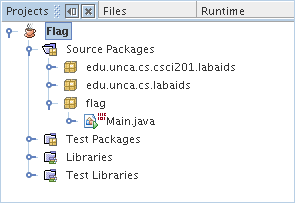home | homework index | labs index
|
|
CSCI 201
Introduction to Algorithm Design home | homework index | labs index |
FALL 2006 |
This lab will test your ability to use Java's conditional statements and relational operators while you draw some flags.
One of the simplest form of conditional
statement is the if statement.
This statement directly translates into:
if a test is true, then
do this, else do that - decisions that you
make each and every day of your life. Some examples:
The last statement above is very close to what computers do, here is that statement translated into Java:
if ( X > 5 ) { // IF X is greater than 5
System.out.println( X ); // THEN Output X
} else { // ELSE
X = X + 1; // Add 1 to X
}
Notice, first comes the word if, then a
test within parenthesis,
then the true, or then, block of code
enclosed in curly braces ({}),
then the false, or else, block of code
enclosed in curly braces.
The else portion of the statement can be omitted,
in which case, nothing is done if the condition is false.
As it turns out, in those cases in which either the true or else block is a single statement long, the curly braces can be omitted. This allows the conditional statement shown above to be re-written as follows:
if ( X > 5 ) // IF X is greater than 5
System.out.println( X ); // THEN Output X
else // ELSE
X = X + 1; // Add 1 to X
Unfortunately, even experienced programs can make mistakes when they avoid the braces, so we suggest you try to use them, especially when writing your first few programs.
It is very important that you indent, with a consistent number of spaces, the then and else blocks of your code. Condition expressions with messy indentations are extremely difficult to comprehend and are always the sign of a poorly designed program. Turning in a programming assignment with poor indentation is certain to lower your grade.
if ( X > 5 ) {
System.out.println( X );
}
else {
X = X + 1;
}
Step through the following example to see a couple of conditional statements in action.
|
Code
int test = 15;
if (test > 30) { System.out.println("one"); } if (test == 15) { System.out.println("two"); } else { System.out.println("Not two"); } |
Stack
|
Heap
|
|
Temporary
|
What makes conditional statements so powerful
is that almost any code can go in the then or else blocks.
But to use an if statement,
you must know how to correctly specify a test.
The test, which is always placed in parenthesis, must be an expression that evaluates to
either a boolean values, that is,
true or false.
Relational operators are
binary operators that compare two values and generate a
boolean result. The following table
contains the relational operators of Java.
x < y |
x is less than y |
x <= y |
x is less than or equal to y |
x > y |
x is greater than y |
x >= y |
x is greater than or equal to y |
x == y |
x is equal to y |
x != y |
x is not equal to y |
But that's not all. You can also use logical operators to create conditions. They allow you to execute blocks under more complex conditions, such as when Income is greater than 15000 and Income is less than 40000. Java pretty much sticks with the the same three operators defined by George Boole by 1854 in "An Investigation Into the Laws of Thought, on Which are founded the Mathematical Thories of Logic and Probabilities". However, Java requires these operators to be written in a most peculiar fashion.
P && Q |
True only when both P and Q are true |
P || Q |
True if at least one of P and Q are true |
! P |
True only if P is false |
Because && and || have a lower
level of precedence than the relational operators, you
can write Java tests like "Income > 15000 &&
Income < 4000" without using
parenthesis. Following the convention of decades of logicians,
&& has a higher precedence than
||.
Download Flag.zip, a ZIP file containing a NetBeans project named
Flag and unZIP this project
into your csci/201 directory.
Try to make your Projects panel look
something like the following picture before continuing.
